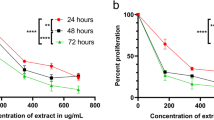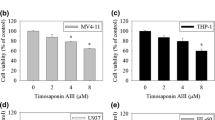Abstract
Purpose
The presence of triterpene saponins in Corchorus acutangulus Lam. has been reported. However, no studies concerning biological activity of the plant extracts have been done so far. In the present study, the anti-leukemic activity of the methanol extract of aerial parts (ME) of C. acutangulus has been investigated, and efforts have been made to identify the active ingredient responsible for this activity.
Methods
The anti-leukemic activity of ME, its fractions and corchorusin-D (COR-D), the active ingredient, was investigated in leukemic cell lines U937 and HL-60 using cell viability and MTT assays. The molecular pathways leading to the activity of COR-D were examined by confocal microscopy, flow-cytometry, caspase and Western blot assays.
Results
ME, its n-butanolic fraction and COR-D inhibited cell growth and produced significant cytotoxicity in leukemic cell lines U937 and HL-60. COR-D produced apoptotic cell death via mitochondrial disfunction and was found to pursue the intrinsic pathway by inciting the release of apoptosis-inducing factors (AIFs) from mitochondria. COR-D-induced translocation of Bax from cytosol to mitochondria facilitating caspase-9 activation and up regulation of downstream pathways leading to caspase-3 activation and PARP cleavage, which resulted in the subsequent accumulation of cells in the sub-G0 phase followed by DNA fragmentation.
Conclusions
COR-D possesses significant anti-leukemic activity in U937 and HL-60 cell lines by acting on the mitochondrial apoptotic pathways. Since the necrotic body formation is low after COR-D treatment, the occurrence of inflammation in in vivo systems could be reduced, which represents a positive indication in view of therapeutic application.






Similar content being viewed by others
References
Ali SI, Nasir E (1974) Flora of Pakistan, No 75, Ferozsons, Karachi, Pakistan, p 28
Mahato SB, Pal BC (1987) Triterpenoid glycosides of Corchorus acutangulus Lam. J Chem Soc. Perkin Trans 1:629–634
Hsu MJ, Cheng JS, Huang HC (2000) Effect of saikosaponin, a triterpene saponin, on apoptosis in lymphocytes: association with c-myc, p53, and bcl-2 mRNA. Brit J Pharmacol 131:1285–1293
Hsu YL, Kuo PL, Lin CC (2004) The proliferative inhibition and apoptotic mechanism of Saikosaponin D in human non-small cell lung cancer A549 cells. Life Sci 75:1231–1242
Hsu YL, Kuo PL, Weng TC, Yen MH, Ching LC, Lin CC (2004) The antiproliferative activity of saponin-enriched fraction from Bupleurum Kaoi is through Fas-dependent apoptotic pathway in human non-small cell lung cancer A549 cells. Biol Pharm Bull 27(7):1112–1115
Sun Y, Cai TT, Zhou XB, Xu Q (2009) Saikosaponin a inhibits the proliferation and activation of T cells through cell cycle arrest and induction of apoptosis. Int Immunopharmacol 9:978–983
Bachran C, Bachran S, Sutherland M, Bachran D, Fuchs H (2008) Saponins in tumor therapy. Mini Rev Med Chem 8:575–584
Khan MSY, Bano S, Javed K, Asad Mueed M (2006) A comprehensive review on the chemistry and pharmacology of Corchorus species—a source of cardiac glycosides, triterpenoids, ionones, flavonoids, coumarins, steroids and some other compounds. J Sci Indus Res 65:283–298
Khare CP (2007) Indian medicinal plants—an illustrated dictionary. Springer, Berlin, pp 180–181
Huang QZ, Hong GX, Lo SX (1980) Pharmacology of Corchorus Linn. I. Alcoholic extract and glycoside of the seeds of Corchorus acutangulus. Yao Xue Xue Bao 15:193–197
Murmu N, Mitra S, Das M, Gomes A, Vedasiromoni JR, Ghosh M, Bhattacharya M, Ghosh P, Biswas J, Bhattacharya S, Sur P (2001) Boron compounds against human leukemic cells. J Exp Clin Can Res 20:511–515
Sur P, Chatterjee SP, Roy P, Sur B (1995) 5-Nitrofuran derivatives of fatty acid hydrazides induce differentiation in human myeloid leukemic cell lines. Cancer Lett 94:27–32
Kawada M, Amemiya M, Ishizuka M, Takeuchi T (1999) Differential induction of apoptosis in B16 melanoma and EL-4 lymphoma cells by cytostatin and bactobolin. Jpn J Cancer Res 90:219–225
Herrmann M, Lorenz HM, Voll R, Grunke M, Woith W, Kalden JR (1994) A rapid and simple method for the isolation of apoptotic DNA fragments. Nucleic Acids Res 22:5506–5507
Martin SJ, Reutelingsperger CP, McGahon AJ, Rader JA, van Schie RC, LaFace DM, Green DR (1995) Early redistribution of plasma membrane phosphatidylserine is a general feature of apoptosis regardless of the initiating stimulus: inhibition by overexpression of Bcl-2 and Abl. J Exp Med 182:1545–1556
Surh YJ, Hurh YJ, Kang JY, Lee E, Kong G, Lee SJ (1999) Resveratrol, an antioxidant present in red wine, induces apoptosis in human promyelocytic leukemia (HL-60) cells. Cancer Lett 140:1–10
Park C, Jin CY, Kim GY, Choi IW, Kwon TK, Choi BT, Lee SJ, Lee WH, Choi YH (2008) Induction of apoptosis by esculetin in human leukemia U937 cells through activation of JNK and ERK. Toxicol Appl Pharmacol 227:219–228
Cohen GM, Sun XM, Fearnhead H, MacFarlane M, Brown DG, Snowden RT, Dinsdale D (1994) Formation of large molecular weight fragments of DNA is a key committed step of apoptosis in thymocytes. J Immunol 153:507–516
Hoeijmakers JH (2001) Genome maintenance mechanisms for preventing cancer. Nature 411:366–374
Caldecott KW, Chalmers A (2005) An Achilles’ heel for breast cancer? Nat Struct Mol Biol 12:387–388
Farmer H, McCabe N, Lord CJ, Tutt AN, Johnson DA, Richardson TB, Santarosa M, Dillon KJ, Hickson I, Knights C, Martin NM, Jackson SP, Smith GC, Ashworth A (2005) Targeting the DNA repair defect in BRCA mutant cells as a therapeutic strategy. Nature 434:917–921
Denicourt C, Dowdy SF (2004) Medicine. Targeting apoptotic pathways in cancer cells. Science 305:1411–1413
Ohuchi K, Watanabe M, Ozeki T, Tsurufuji S (1985) Pharmacological influence of saikosaponins on prostaglandin E2 production by peritoneal macrophages. Planta Med 51:208–212
Chen JC, Chang NW, Chung JG, Chen KC (2003) Saikosaponin-A induces apoptotic mechanism in human breast MDA-MB-231 and MCF-7 cancer cells. Am J Chin Med 31:363–377
Wen-Sheng W (2003) ERK signaling pathway is involved in p15INK4b/p16INK4a expression and HepG2 growth inhibition triggered by TPA and Saikosaponin a. Oncogene 22:955–963
Qian L, Murakami T, Kimura Y, Takahashi M, Okita K (2003) Saikosaponin A-induced cell death of a human hepatoma cell line (HUH-7): The significance of the ‘sub-G1 peak in a DNA histogram. Pathol Int 45:207–214
Guinea MC, Parellada J, Lacaille-Dubois MA, Wagner H (1994) Biologically active triterpene saponins from Bupleurum fruticosum. Planta Med 60:163–167
Kato M, Pu MY, Isobe K, Hattori T, Yanagita N, Nakashima I (1995) Cell type-oriented differential modulatory actions of saikosaponin-d on growth responses and DNA fragmentation of lymphocytes triggered by receptor-mediated and receptor-bypassed pathways. Immunopharmacol 29:207–213
Konoshima T, Takasaki M, Ichiishi E, Murakami T, Tokuda H, Nishino H, Duc NM, Kasai R, Yamasaki K (1999) Cancer chemopreventive activity of majonoside-R2 from Vietnamese ginseng, Panax vietnamensis. Cancer Lett 147:11–16
Darzynkiewicz Z, Bruno S, Del Bino G, Gorczyca W, Hotz MA, Lassota P, Traganos F (1992) Features of apoptotic cells measured by flow cytometry. Cytometry 13:795–808
Roy MK, Thalang VN, Trakoontivakorn G, Nakahara K (2004) Mechanism of mahanine-Induced apoptosis in human leukemia cells (HL-60). Biochem Pharmacol 67:41–51
Yang J, Liu X, Bhalla K, Kim CN, Ibrado AM, Cai J, Peng TI, Jones DP, Wang X (1997) Prevention of apoptosis by Bcl-2: release of cytochrome c from mitochondria blocked. Science 275:1129–1132
Patel T, Gores GJ, Kaufmann SH (1996) The role of proteases during apoptosis. FASEB J 10:587–597
Nicholson DW, Ali A, Thornberry NA, Vaillancourt JP, Ding CK, Gallant M, Gareau Y, Griffin PR, Labelle M, Lazebnik YA, Munday NA, Raju SM, Smulson ME, Yamin TT, Yu VL, Miller DK (1995) Identification and inhibition of the ICE/CED-3 protease necessary for mammalian apoptosis. Nature 376:37–43
Salvesen GS, Dixit VM (1999) Caspase activation: the induced-proximity model. Proc Natl Acad Sci USA 96:10964–10967
Conflict of interest statement
None.
Author information
Authors and Affiliations
Corresponding author
Rights and permissions
About this article
Cite this article
Mallick, S., Ghosh, P., Samanta, S.K. et al. Corchorusin-D, a saikosaponin-like compound isolated from Corchorus acutangulus Lam., targets mitochondrial apoptotic pathways in leukemic cell lines (HL-60 and U937). Cancer Chemother Pharmacol 66, 709–719 (2010). https://doi.org/10.1007/s00280-009-1214-3
Received:
Accepted:
Published:
Issue Date:
DOI: https://doi.org/10.1007/s00280-009-1214-3




